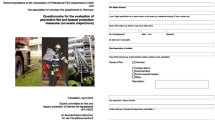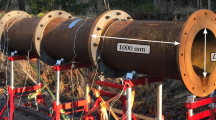Abstract
A computer model that simulates fire growth movement in tunnels is described, and a brief overview of tunnel systems is presented. The methods for predicting mass flows, velocities, smoke concentrations, and heat transfer are presented, along with a list of hazard output parameters. The validation of the model against experiment, and possible directions for future work are also presented.
Similar content being viewed by others
References
Bertrand, A., “Opening Address,”Safety in Road and Rail Tunnels, 1992.
Haack, A., “Fire Protection Traffic Tunnels-Initial Recognitions from Large Scale Tests,”Safety in Road and Rail Tunnels, 1992.
Luchian, S.F., “The Central Artery/Tunnel Project Memorial Tunnel Fire Test Program,”Safety in Road and Rail Tunnels, 1992.
Thomas, P.H., “The Movement of Buoyant Fluid Against a Stream and the Venting of Underground Fires,”Fire Research Note 351/1958, Fire Research Station, U.K., 1958.
Thomas, P.H., “The Movement of Smoke in Horizontal Passages Against an Air Flow,”Fire Research Note 723/1968, Fire Research Station, U.K., 1968.
Charters, D.A., “Fire Risk Assessment in Rail Tunnels,”Safety in Road and Rail Tunnels, 1992.
Considine, M., Parry, S.T., and Blything, K.,Risk Assessments of Hazardous Substances Through Road Tunnels in the United Kingdom, Department of Transport, 1989.
Miclea, P.C. and Murphy, R.E., “Assessment of Emergency Ventilation Capability in Case of Train Fire in a Tunnel Using Subway Environment Simulation (SES) Computer Program,”Proceedings of 4th U.S. Mine Ventilation Symposium, SME, 1989.
Laage, L.W. and Yang, H., “Mine Fire Experiments at the Waldo Mine,”Proceedings of 5th U.S. Mine Ventilation Symposium, SME, 1991.
Kumar, S. and Cox, G.,Mathematical Modeling of Fire in Road Tunnels—Validation of JASMINE Department of Transport, 1986.
Simcox, S., Wilkies, N.S. and Jones, I.P., “Computer Simulation of the Flows of Hot Gases from Fire at King's Cross Underground Station,”Institution of Mechanical Engineers, 1989.
Charters, D.A., Gray, W. A., and McIntosh, A.C.,FASIT Tunnel Fire Computer Model—Physical Basis, AEA Technology/Leeds University, 1993.
Heskestad, G., “Fire Plumes,”The SFPE Handbook of Fire Protection Engineering, SFPE/NFPA, 1988, Chapters 1–6.
Drysdale, D.D.,An Introduction to Fire Dynamics, Wiley, 1985.
British Standard (Draft for Development) 180,Guide for the Assessment of Toxic Hazards in Fire in Buildings and Transport British Standards Institution, 1989.
Vantelon, J.P.,et al., Investigation of Fire-Induced Smoke Movement in Tunnels and Stations: An Application to the Paris Metro, Third International Symposium on Fire Safety Science, Elsevier, 1991.
Heselden, A.J.M., “Studies of Fire and Smoke Behavior Relevant to Tunnels,”Current Paper CP66/78, Building Research Establishment, 1978.
Emmons, H.W., “The Ceiling Jet in Fires,”Proceedings of the 3rd International Symposium of Fire Safety Science, Elsevier, 1991.
Carslaw, H.S. and Jaeger, J.C.,Conduction of Heat in Solids, 2nd edition, Oxford University Press, 1959.
Final Report on the Tests in the Ofenegg Tunnel, Commission for Safety Measures in Road Tunnels, Bern, 1965.
Feizlmayr, A.H.,Brandversuche in Einen Tunnel, Bundesministerium für Banten und Technik, Heft 50, Vienna, 1976.
Keski-Rahkonen, O., Holmlund, C., Loikkanen, P., Ludrigsen, H., and Mikkola, E.,Two Full-Scale Pilot Fire Experiments in a Tunnel, VTT Finland, 1986.
Marshall, I.A., Hines, M.A., Cutler, D.P., and Packer, S.D.,Fire Gallery Tests for Non-Metallic Materials Intended for Underground Use Project No. 7255-10/058, CEC, 1984.
Private communication between Beckett, H. (HSE) and Burke, G. (AEA), 1986.
McCaughey, M.N. and Fletcher, D.F.,Simulation of a Fire in a Tunnel, SRD, 1992.
Fletcher, D.F. and Owens, M.P.,Tunnel Fire Modeling Using FLOW 3D: Progress and Suggested Future Work, SRD, 1993.
Author information
Authors and Affiliations
Additional information
(previously with AEA Consultancy Services)
Rights and permissions
About this article
Cite this article
Charters, D.A., Gray, W.A. & McIntosh, A.C. A computer model to assess fire hazards in tunnels (FASIT). Fire Technol 30, 134–154 (1994). https://doi.org/10.1007/BF01040993
Issue Date:
DOI: https://doi.org/10.1007/BF01040993




